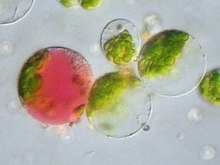Protoplast


Protoplast (from
by mechanical, chemical or enzymatic means.Protoplasts differ from
Enzymes for the preparation of protoplasts
Cell walls are made of a variety of polysaccharides. Protoplasts can be made by degrading cell walls with a mixture of the appropriate polysaccharide-degrading enzymes:
| Type of cell | Enzyme |
|---|---|
| Plant cells | Cellulase, pectinase, xylanase[3] |
Gram-positive bacteria
|
Lysozyme, N,O-diacetylmuramidase, lysostaphin[4] |
| Fungal cells | Chitinase[6] |
During and subsequent to digestion of the cell wall, the protoplast becomes very sensitive to
Uses for protoplasts

Protoplasts can be used to study membrane biology, including the uptake of macromolecules and viruses . These are also used in somaclonal variation.
Protoplasts are widely used for
Protoplasts may also be used for
Additionally, protoplasts of plants expressing fluorescent proteins in certain cells may be used for Fluorescence Activated Cell Sorting (FACS), where only cells fluorescing a selected wavelength are retained. Among other things, this technique is used to isolate specific cell types (e.g.,
See also
References
- ^ Hanstein, J (1880). Das Protoplasma. Heidelberg.
- ^ Sharp, LW (1921). Introduction To Cytology. New York: McGraw Hill, p. 24.
- ^ PMID 15694124.
- ^ S2CID 2065821.
- ^ a b c d "Protoplasts and spheroplasts". www.encyclopedia.com. Encyclopedia.com. 2016. Retrieved July 21, 2019.
- ^ S2CID 852042.
- ^ "Definition of spheroplast". www.merriam-webster.com. Merriam-Webster. 2019. Retrieved July 21, 2019.
- S2CID 25641573.
- ^ Bhatla SC, Kiessling J, Reski R (2002): Observation of polarity induction by cytochemical localization of phenylalkylamine-binding receptors in regenerating protoplasts of the moss Physcomitrella patens. Protoplasma 219, 99–105.
- ^ Hain R, Czernilofsky AP, et al. (1985). "Uptake, integration, expression and genetic transmission of a selectable chimaeric gene by plant protoplasts". Molecular and General Genetics 199:161–168.
